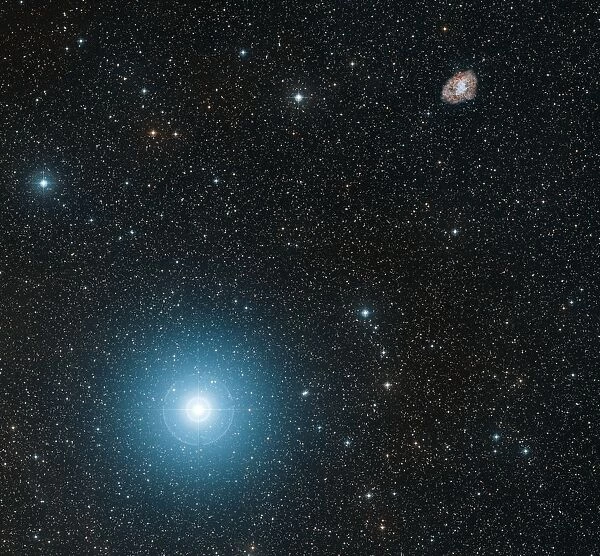Crab nebula and Zeta Tauri star
![]()

Wall Art and Photo Gifts from Science Photo Library
Crab nebula and Zeta Tauri star
Crab nebula (M1, upper right) and the star Zeta Tauri (lower left). The Crab nebula is a supernova remnant, expanding shells of gas cast off by a supernova, the explosive death of a massive star. The Crab nebula is notable as its explosion was recorded by Chinese and Arab astronomers in 1054 AD, when it appeared as a new star, which was visible in daylight and faded slowly over two years before becoming invisible to the naked eye. The supernova remnant itself was discovered in 1731, although it takes its M1 classification from its later discovery by Charles Messier in 1758, when he gave it the first number in his catalogue of objects. Photographed by the 1.22 metres Oschin Telescope, Mount Palomar, California, USA
Science Photo Library features Science and Medical images including photos and illustrations
Media ID 6441903
© DAVIDE DE MARTIN/SCIENCE PHOTO LIBRARY
Astrophysical Astrophysics Crab Nebula Explosion Observatory Oschin Telescope Pulsar Star Star Death Stellar Supernova Remnant Taurus Telescope
EDITORS COMMENTS
This print showcases the mesmerizing beauty of the Crab Nebula and Zeta Tauri star, captured by the powerful 1.22 meters Oschin Telescope in Mount Palomar, California. The Crab Nebula, located in the upper right corner of the image, is a remarkable supernova remnant resulting from the explosive demise of a massive star. Its expanding shells of gas are remnants cast off during this cataclysmic event. What makes the Crab Nebula even more extraordinary is its historical significance. Chinese and Arab astronomers recorded its explosion back in 1054 AD when it appeared as a new star visible even during daylight. Over two years, it gradually faded before disappearing from naked eye visibility altogether. Although discovered as a supernova remnant in 1731, Charles Messier officially cataloged it as M1 in his renowned collection of celestial objects in 1758. Today, scientists continue to study this cosmic wonder to unravel its mysteries and gain insights into stellar evolution. Accompanying this awe-inspiring nebula is Zeta Tauri star residing at the lower left side of the photograph. Together with their contrasting colors and luminosities, these celestial entities create an enchanting scene against the backdrop of space. Thanks to Science Photo Library's exceptional expertise and equipment like Oschin Telescope, we can now admire this breathtaking snapshot that combines artistry with scientific exploration—showcasing our universe's immense wonders for all to appreciate.
MADE IN THE USA
Safe Shipping with 30 Day Money Back Guarantee
FREE PERSONALISATION*
We are proud to offer a range of customisation features including Personalised Captions, Color Filters and Picture Zoom Tools
SECURE PAYMENTS
We happily accept a wide range of payment options so you can pay for the things you need in the way that is most convenient for you
* Options may vary by product and licensing agreement. Zoomed Pictures can be adjusted in the Cart.


